


The Mortzenhaus was one of the largest and best-known city palaces in Hamburg. It was built in 1621 by the brothers and arms dealers Jacob and Hans Moers, who were among the wealthiest people in Hamburg in their lifetime.



The Mortzenhaus was one of the largest and best-known city palaces in Hamburg. It was built in 1621 by the brothers and arms dealers Jacob and Hans Moers, who were among the wealthiest people in Hamburg in their lifetime.
Built as a palace in renaissance style and occupying the addresses Alter Wandrahm 19–23, it was markedly different from most other buildings in Hamburg. [1]
The Mortzenhaus was demolished in 1886 as part of the construction of the Speicherstadt .

The Hanseaten is a collective term for the hierarchy group consisting of elite individuals and families of prestigious rank who constituted the ruling class of the free imperial city of Hamburg, conjointly with the equal First Families of the free imperial cities of Bremen and Lübeck. The members of these First Families were the persons in possession of hereditary grand burghership of these cities, including the mayors, the senators, joint diplomats and the senior pastors. Hanseaten refers specifically to the ruling families of Hamburg, Lübeck and Bremen, but more broadly, this group is also referred to as patricians along with similar social groups elsewhere in continental Europe.

Joh. Berenberg, Gossler & Co. KG, commonly known as Berenberg Bank and also branded as simply Berenberg, is a multinational full-service private and merchant bank headquartered in Hamburg, Germany. It is considered the world's oldest merchant bank.

Ludwig Erdwin Seyler was a Hamburg merchant, merchant banker and politician. He was by marriage a member of the Hanseatic Berenberg dynasty, and was a partner in the Hamburg firm Joh. Berenberg, Gossler & Co. for 48 years (1788–1836), for 46 years as the company's senior partner. The company name was amended in 1791 to reflect him becoming a partner and has remained unchanged since; he "is practically the 'Co.' in the company name." Seyler was one of the first merchants and bankers from modern Germany to establish trade relations with the United States and East Asia. Much of the company's wealth derived from their position as leading sugar importers from the Americas to the North European market, in combination with their activities as merchants bankers. Seyler was one of Hamburg's leading merchants during the Napoleonic Wars and held several political offices. He served as a member of the French-appointed council of Hamburg and after the Napoleonic Wars as the President of the Commercial Deputation, one of the city-state's main political bodies. Ludwig Seyler was a son of the Swiss-born theatre director Abel Seyler and a son-in-law of the bankers Johann Hinrich Gossler and Elisabeth Berenberg through his marriage to their eldest daughter Anna Henriette Gossler.

Johann Hinrich Gossler was a German merchant and banker. He was married to Elisabeth Berenberg (1749–1822) and succeeded his father-in-law Johann Berenberg as head of the Berenberg & Gossler company, that was renamed Joh. Berenberg, Gossler & Co. the year following his death. During Gossler's tenure as the company's main partner it became one of the largest merchant houses of Hamburg. Many of his descendants were prominent in Hamburg society, including his grandson, Hamburg's first mayor Hermann Gossler. Some of his descendants were later ennobled as the barons von Berenberg-Gossler. The Gossler Islands in Antarctica are named in honour of his family.

Hermann Gossler was a Hamburg lawyer, senator (1842–77) and First Mayor and President of the Senate of the Free and Hanseatic City of Hamburg in 1874. He was Second Mayor in 1870, 1871 and 1873. During much of his tenure as senator and his first term as Second Mayor, Hamburg was a fully sovereign country, while after 1871, the First Mayor as head of state of republican Hamburg was equal to the federal princes (Bundesfürsten) within the German Empire. As a senator, he also served as Lord of Police (Polizeiherr), the equivalent of a Minister of Police.
John von Berenberg-Gossler was a Hamburg banker, politician and grand burgher.

The Berenberg family was a Flemish-origined Hanseatic family of merchants, bankers and senators in Hamburg, with branches in London, Livorno and other European cities. The family was descended from the brothers Hans and Paul Berenberg from Antwerp, who came as Protestant refugees to the city-republic of Hamburg following the Fall of Antwerp in 1585 and who established what is now Berenberg Bank in Hamburg in 1590. The Berenbergs were originally cloth merchants and became involved in merchant banking in the 17th century. Having existed continuously since 1590, Berenberg Bank is the world's oldest surviving merchant bank.
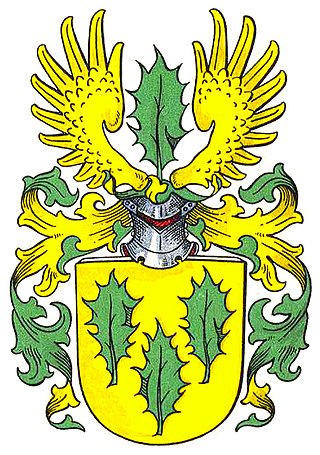
The Amsinck family is a Dutch-origined patrician family whose members were prominent merchants in multiple countries including the Netherlands, Hamburg, Portugal, England, France, Hanover, Holstein, Denmark, Suriname and India. From the 17th century the Hamburg branch of the family formed part of the city-state's ruling class, the Hanseaten or hereditary grand burghers, who enjoyed legal privileges in Hamburg until 1918. Amsinck has been one of Hamburg's great business families over many centuries, and its members reached the highest positions in Hamburg society, including as senators and head of state. A branch of the family were large plantation owners in Suriname. The Hamburg branch retained a Dutch identity for centuries, often intermarrying with other Dutch-origined patrician families.

Johann Heinrich Gossler was a Hamburg banker and grand burgher, a member of the Berenberg-Gossler-Seyler banking dynasty, a co-owner of the Berenberg Bank and a senator of Hamburg from 1821. He was the son of Johann Hinrich Gossler and Elisabeth Berenberg (1749–1822), and the brother in law of Ludwig Erdwin Seyler. He was the father of Hamburg First Mayor Hermann Gossler and the grandfather of Baron Johann von Berenberg-Gossler (1839–1913). He was also the great-grandfather of First Mayor Johann Heinrich Burchard.
Baron Johann von Berenberg-Gossler, known as "John", was a German banker from the city-state of Hamburg and owner and head of Berenberg Bank from 1879 until his death.

Johann Heinrich Burchard was a Hamburg lawyer and politician who served as senator and First Mayor and President of the Senate of the Free and Hanseatic City of Hamburg.

The Seyler family is a Swiss family, originally a patrician family from Liestal near Basel. Family members served as councillors and Schultheißen of Liestal from the 15th century, later also as members of the Grand Council of Basel. A Hamburg branch descended from the banker and renowned theatre director Abel Seyler became by marriage a part of the Berenberg banking dynasty, co-owners of Berenberg Bank and part of Hamburg's ruling class of Hanseaten.
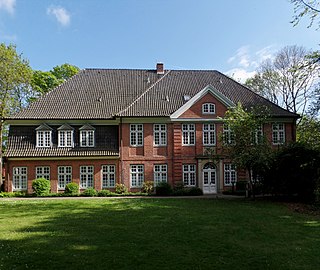
The Frustberg House, also known as the Tiefbrunn House, is a former property and a baroque brick manor house at Frustberg in the Hamburg borough of Groß Borstel. The property became a summer residence for wealthy Hamburg citizens from 1651. The current house was built in the early 18th century by the cloth merchant Eybert Tiefbrunn, and his coat of arms is still found over the main entrance door, with the year 1703 inscribed. The building is a rare example of a baroque brick building from the era. In the 19th century, the property included an estate of 605 hectare land, and the manor house was surrounded by 7 hectare park.
Rudolf Berenberg was a Hamburg merchant and banker and a member of the Berenberg banking family. He served as President of the Commerz-Deputation from 1728–1729 and as a Hamburg Senator from 1735. He was the son of Cornelius Berenberg (1634–1711), and was married to Anna Elisabeth Amsinck (1690–1748), a daughter of Paul Amsinck (1649–1706) and Christina Adelheid Capelle (1663–1730).
Paul Berenberg was a Hamburg merchant and banker and a member of the Berenberg banking family. He served as a Senator of Hamburg, succeeding his father Rudolf Berenberg.
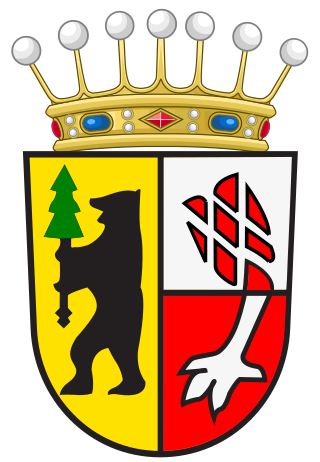
Baron of Berenberg-Gossler is a title in the German nobility, specifically the nobility of the Kingdom of Prussia, created in 1910 for banker Johann von Berenberg-Gossler of the Hamburg Hanseatic Berenberg-Gossler family. The title is held by one person at a time and is tied to an entailed estate (Fideikommiss), Gut Niendorf. For this reason, it is not always inherited by the eldest son. The title is currently held by humanitarian Cornelius von Berenberg-Gossler. The first three title holders were all heads of Berenberg Bank.

Elisabeth Berenberg was a Hamburg heiress, merchant banker and a member of the Berenberg family. She was the last male line member of the Flemish-origined Hanseatic Berenberg banking family in Hamburg, and ancestral mother of the von Berenberg-Gossler family, the current owners of Berenberg Bank. She is also noted as the only woman ever to serve as a partner and take an active leadership role (1790–1800) at Berenberg Bank since the company was established in 1590 by her family.
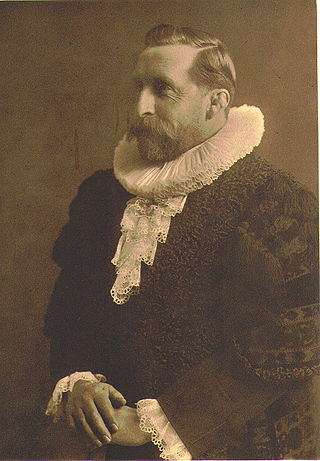
Max Garlieb August Predöhl was a Hamburg lawyer and politician. He served as Senator and First Mayor of Hamburg.

The Gossler family, including the Berenberg-Gossler branch, is a Hanseatic and partially noble banking family from Hamburg.
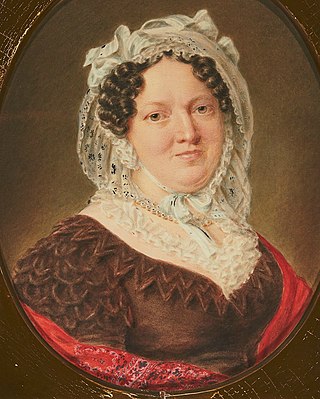
Anna Henriette Gossler was a Hamburg banker, heiress and socialite.